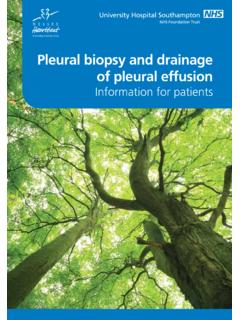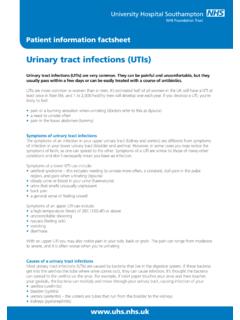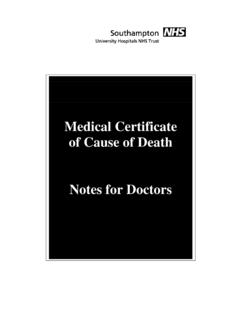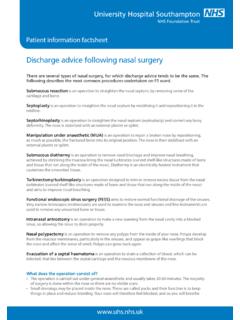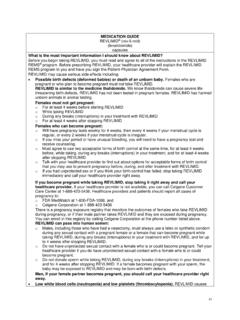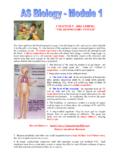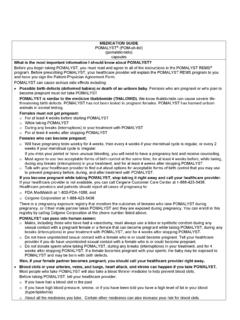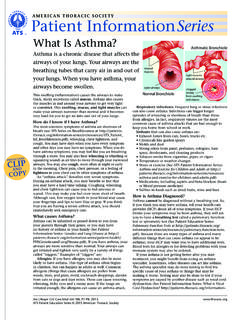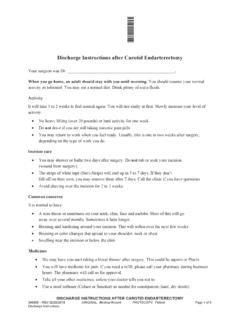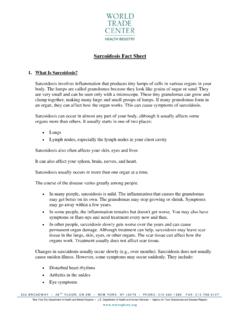Transcription of Lobectomy via thoracotomy - UHS
1 Lobectomy via thoracotomyInformation for patientsThis leaflet will explain the reasons for the operation, the procedure itself and potential risks involved. It will also explain the care you will need before and after the operation. Please feel free to ask any questions raised or not addressed by this leaflet. The doctors and nurses are available to support you at this is an incision made on the chest to gain access to organs within it. Lobectomy is removal of one of the lobes of the are referred to thoracic (chest) surgeons for management and/or investigation of an abnormality found in the lung. This includes known or suspected lung cancers and other conditions such as chronic infection. Published evidence indicates successful surgery for early stage lung cancer gives the best chance of a cure, although no treatment offers a for early stage lung cancer involves removing the part of the lung containing the cancer and the lymph glands in the surrounding regions.
2 All the tissue removed is sent to the laboratory for analysis. Based on the results, patients may benefit from chemotherapy and/or radiotherapy after your outpatient appointment, you will have discussed with your surgeon the reasons for offering surgery, risks and benefits, what is involved and alternative treatments. When patients are unwilling or unfit for surgery the surgeon will provide guidance on options for alternative is your decision to choose surgery or other forms of treatment. The doctors and nurses will be available to offer information, advice and support at this time. Please feel free to ask any questions and discuss concerns you may for patients3 SurgeryThe operation is done under a general anaesthetic and takes between one and three is routine practice to check the airway for any abnormality. This is done using a bronchoscope (surgical telescope) put into your windpipe, via your will then be positioned on your side with your arm above your head.
3 The surgeon will make a cut starting under your shoulder blade, along the line of the rib. The ribs are separated from each other to gain access to the organs within. Occasionally ribs may be broken during this lungs consist of five lobes. There are two lobes in the left lung and three in the right lung. One or more of these lobes may be removed during surgery along with their surrounding lymph the diagnosis has not been established, a sample of the abnormal tissue may be sent to the laboratory for a quick analysis while you are under anaesthetic. This is called a frozen section examination and normally adds 20 minutes to the length of the operation. Based on the findings of the frozen section examination, the surgeon may proceed to remove the lobe containing the abnormality from the lung. However; this may not always be the end of the procedure, the wound will be closed with stitches in layers.
4 Most surgeons use absorbable stitches under the skin. These will dissolve over the next few months, so therefore do not need or two chest tubes will be inserted at the end of the operation, to collect air and fluid from the operation site. The drains are secured with a stitch and an additional one to close the skin defect when the drain/s are removed. The stitch/es will need to be removed about seven days after the drain comes out, by the practice nurse at your GP surgery or by the district for patients54 Lobectomy via thoracotomyChanges to the planned surgeryVery occasionally unexpected findings come to light during the operation. These may influence the method and extent of your surgery. This means sometimes more extensive surgery than planned is needed, but on other occasions may mean that it is not possible to remove the lesion. If this happens your surgeon will explain treatment options which may include chemotherapy and surgeon will only do what is appropriate to your condition.
5 If there has been any change to the planned operation the surgeon will always explain to you what has been done and the reasons for surgeryIf you smoke, we strongly recommend that you stop smoking before your know that patients who smoke up to four weeks before chest surgery run a higher risk of developing complications after reduce the risk of infection, you will need to have a bath or shower in an antiseptic solution the night before your operation. We will supply this special liquid must not eat anything after midnight the night before your operation. After midnight you can only drink water, and you must stop this at you take any medications the nurses will advise you which you may take before your may be admitted to hospital the day before your operation. On admission you will need to have the following tests: Blood tests ECG heart tracing Chest x-ray Breathing tests - pulmonary function (if not done previously) A full set of observations - blood pressure, pulse, oxygen levels temperature, respiratory rate, weight and patients are screened for MRSA infection on nurse will need to complete some paperwork and a doctor or nurse specialist/practitioner will take a medical history and do an examination.
6 This may have been done in a pre-admission anaesthetist will see you to discuss having a general anaesthetic. Pre-medications are not given routinely; however if you are particularly anxious then please mention this to the you need other tests specific to you these will be procedure will be explained to you again and any questions you may have will be everything has been completed, a doctor will ask you to sign a consent form giving your permission (consent) for the operation to take place. On the morning of your operation you may need to have your chest, back and underarm shaved with special clippers. You will need to have another bath, shower, or full wash and a hair wash in the antiseptic solution. After this you will be asked to put on a hospital gown. You will also need to wear compression stockings, which help to prevent you developing blood clots in your legs.
7 Before your operation a doctor will mark the side you are to be operated on. Please let a member of staff know it this gets washed will give you two name bands to wear, with the ward, your name, your date of birth and hospital number on. In addition if you are allergic to anything you will need to wear a red band. Please let a member of staff know if you lose one, or if any of the information is going to theatre the nurses will complete a checklist with you, which will be repeated several times when you go to theatre. This is for your for patients7 Lobectomy via thoracotomy6 After the operationAfter the operation you will be taken to the recovery room. The staff will be constantly monitoring you and making you comfortable. Once they are happy with your condition you will return to the ward. You will normally stay in recovery for about two hours. Some patients will have a chest you get back to the ward you will go to an area where we can closely monitor you for the first part of your will have oxygen via a mask, which will need to stay on for at least the first few will not be able to drink for four hours after your operation.
8 A tube going into a vein will give you fluids until you can drink chest drain normally stays in for 24 to 48 hours, depending on how much drainage there is and if there is an air leak. If an air leak is present the drain will need to stay in until it stops. The nurses will be measuring the amount of drainage from your drain/s. With this information and a chest x-ray the doctors will decide when the drain/s can be may have a tube in your bladder to measure your urine; this will normally be taken out the next will show you how to do breathing exercises and how to cough to help prevent a chest infection. You will be shown how to exercise your shoulder to prevent getting a frozen shoulder. It is very important to do these exercises as they will help with your recovery. You will need to wear compression stockings which help with your circulation. It is important to wear these daily until you are fully recovered.
9 You will also need to have daily injections of a blood-thinning drug until you are more mobile. These are all to help prevent a blood clot forming after your reliefAfter your operation you will need to have some pain relief. This is normally by patient controlled analgesia (PCA), a device designed to ensure you receive safe levels of pain relief. It consists of a syringe containing pain relief medication, attached to a vein in your arm. When you require pain relief you press a button to release a dose. You may also have some local anaesthetic infused into your wound for some time after surgery to help with the pain. As your pain improves you will be given tablets and the PCA and local anaesthetic will be nursing staff will be monitoring your pain levels so please tell them if your pain is not careYou will need help to begin with but gradually you will be able to do more for can eat the following day, but expect to have a poor appetite to begin majority of patients having this surgery will find they are able to start walking around on the first day after their operation.
10 Gradually as you recover you will be expected to move more, but be careful not to over do it. The nurses and physiotherapists will help you decide how much you should will have a dressing over your wound that will be removed 24 to 48 hours after the operation. If the wound is clean and dry it will be left without a dressing. If it is still oozy then a light dressing will be put on and changed daily until no longer drain/s will have a dressing around them that will be changed daily or on alternate days as necessary. Once the drain/s are removed you will need a dressing over the site for 24 to 48 hours, or longer if would hope that by the time you go home you will be comfortable and gently walking around the ward. your pain should be controlled on tablets, and you should be able to shower or wash yourself, and get yourself dressed. You may still need some help to wash your back and doctors will come and see you every day to discuss your progress.
